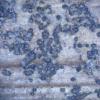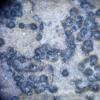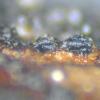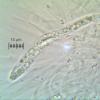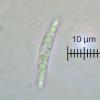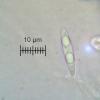
24-12-2025 17:08
Hulda Caroline HolteHello, I have found this propoloid ascomycete on

21-12-2025 09:32
Hello.A tiny ascomycete found embedded in wood in

21-12-2025 21:32
Pol DebaenstHello, Garden, Burgweg 19, Veurne, BelgiumOn 10/1

22-12-2025 23:38
Patrice TANCHAUDBonsoir, récolte sur un mur en pierre, apothéci

22-12-2025 00:47
Patrice TANCHAUDBonsoir, récolte à proximité du milieu dunaire
Unknown pyreno on wood
Maren Kamke,
19-03-2014 19:51
 Hi everybody,
Hi everybody,I need your help again.
I continue to find this species on decidious wood and old, thick rubus stems. It is very small with a size of 0,2 mm, becoming superficial, gregarious. Spores hyaline without septa, but I'm not sure if they become 3-septate with age, (19-23) 21,33 x 4,25 (4-5) µm. Asci 85-101x6-8 µm, IKl negative, biseriat with croziers.
Thanks
Maren
Enrique Rubio,
19-03-2014 19:56
Re : Unknown pyreno on wood
Hi Maren
I feel your fungus is close to Paradidymella clarkii
Gernot Friebes,
19-03-2014 20:04
Re : Unknown pyreno on wood
Hi Maren,
maybe a Chaetosphaeria?
Best wishes,
Gernot
maybe a Chaetosphaeria?
Best wishes,
Gernot
Björn Wergen,
20-03-2014 12:17

Re : Unknown pyreno on wood
Hi Maren,
Gernot is right, this is maybe Chaetosphaeria. Compare it with C. cupulifera, which I have already found on different hosts, like Clematis.
Do the spores have a septation when getting older?
regards,
björn
Gernot is right, this is maybe Chaetosphaeria. Compare it with C. cupulifera, which I have already found on different hosts, like Clematis.
Do the spores have a septation when getting older?
regards,
björn
Maren Kamke,
20-03-2014 20:29

Re : Unknown pyreno on wood
Yes, I think it is a Chaetosphaeria. Thank you for your comments.
Meanwhile the spores became 1-septate. I'll be watching the development. C. cupulifera fits the description of Ellis quite well. The conidial stage I can not comment. In addition to the key in Ellis I have only found the key of Réblova. Is there anything else?
Regards,
Maren
Björn Wergen,
21-03-2014 16:32

Re : Unknown pyreno on wood
Hi Maren,
I do not have anything else except the erection of the family Chaetosphaeriaceae a year before Réblovà has written her paper about the genus Chaetosphaeria. There is just a key to Chaetosphaeriaceae genera with some comments.
regards,
björn
I do not have anything else except the erection of the family Chaetosphaeriaceae a year before Réblovà has written her paper about the genus Chaetosphaeria. There is just a key to Chaetosphaeriaceae genera with some comments.
regards,
björn
